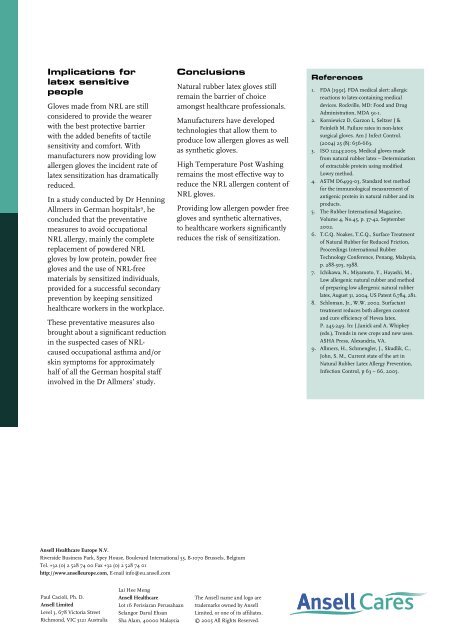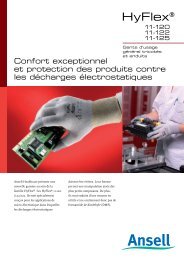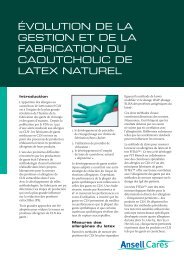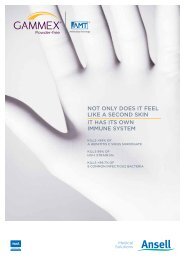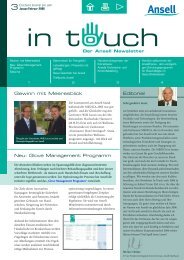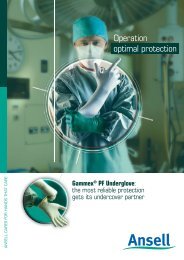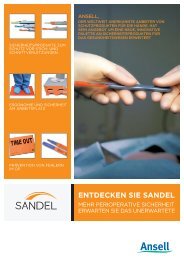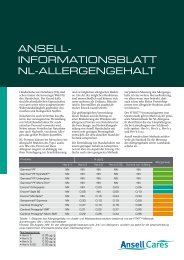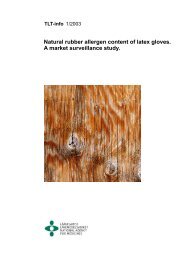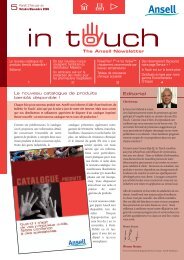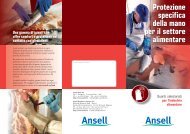Download full document - Ansell Healthcare Europe
Download full document - Ansell Healthcare Europe
Download full document - Ansell Healthcare Europe
You also want an ePaper? Increase the reach of your titles
YUMPU automatically turns print PDFs into web optimized ePapers that Google loves.
Implications for<br />
latex sensitive<br />
people<br />
Gloves made from NRL are still<br />
considered to provide the wearer<br />
with the best protective barrier<br />
with the added benefits of tactile<br />
sensitivity and comfort. With<br />
manufacturers now providing low<br />
allergen gloves the incident rate of<br />
latex sensitization has dramatically<br />
reduced.<br />
In a study conducted by Dr Henning<br />
Allmers in German hospitals 9 , he<br />
concluded that the preventative<br />
measures to avoid occupational<br />
NRL allergy, mainly the complete<br />
replacement of powdered NRL<br />
gloves by low protein, powder free<br />
gloves and the use of NRL-free<br />
materials by sensitized individuals,<br />
provided for a successful secondary<br />
prevention by keeping sensitized<br />
healthcare workers in the workplace.<br />
These preventative measures also<br />
brought about a significant reduction<br />
in the suspected cases of NRLcaused<br />
occupational asthma and/or<br />
skin symptoms for approximately<br />
half of all the German hospital staff<br />
involved in the Dr Allmers’ study.<br />
Conclusions<br />
Natural rubber latex gloves still<br />
remain the barrier of choice<br />
amongst healthcare professionals.<br />
Manufacturers have developed<br />
technologies that allow them to<br />
produce low allergen gloves as well<br />
as synthetic gloves.<br />
High Temperature Post Washing<br />
remains the most effective way to<br />
reduce the NRL allergen content of<br />
NRL gloves.<br />
Providing low allergen powder free<br />
gloves and synthetic alternatives,<br />
to healthcare workers significantly<br />
reduces the risk of sensitization.<br />
<strong>Ansell</strong> <strong>Healthcare</strong> <strong>Europe</strong> N.V.<br />
Riverside Business Park, Spey House, Boulevard International 55, B-1070 Brussels, Belgium<br />
Tel. +32 (0) 2 528 74 00 Fax +32 (0) 2 528 74 01<br />
http://www.anselleurope.com, E-mail info@eu.ansell.com<br />
Paul Cacioli, Ph. D.<br />
<strong>Ansell</strong> Limited<br />
Level 3, 678 Victoria Street<br />
Richmond, VIC 3121 Australia<br />
Lai Hee Meng<br />
<strong>Ansell</strong> <strong>Healthcare</strong><br />
Lot 16 Perisiaran Perusahaan<br />
Selangor Darul Ehsan<br />
Sha Alam, 40000 Malaysia<br />
The <strong>Ansell</strong> name and logo are<br />
trademarks owned by <strong>Ansell</strong><br />
Limited, or one of its affiliates.<br />
© 2005 All Rights Reserved.<br />
References<br />
1. FDA [1991]. FDA medical alert: allergic<br />
reactions to latex-containing medical<br />
devices. Rockville, MD: Food and Drug<br />
Administration, MDA 91-1.<br />
2. Korniewicz D, Garzon L, Seltzer J &<br />
Feinleib M. Failure rates in non-latex<br />
surgical gloves. Am J Infect Control.<br />
(2004) 25 (8): 656-663.<br />
3. ISO 12243:2003, Medical gloves made<br />
from natural rubber latex – Determination<br />
of extractable protein using modified<br />
Lowry method.<br />
4. ASTM D6499-03, Standard test method<br />
for the immunological measurement of<br />
antigenic protein in natural rubber and its<br />
products.<br />
5. The Rubber International Magazine,<br />
Volume 4, No.45, p. 37-42, September<br />
2002.<br />
6. T.C.Q. Noakes, T.C.Q., Surface Treatment<br />
of Natural Rubber for Reduced Friction,<br />
Proceedings International Rubber<br />
Technology Conference, Penang, Malaysia,<br />
p. 288-305, 1988.<br />
7. Ichikawa, N., Miyamoto, Y., Hayashi, M.,<br />
Low allergenic natural rubber and method<br />
of preparing low allergenic natural rubber<br />
latex, August 31, 2004, US Patent 6,784, 281.<br />
8. Schloman, Jr., W.W. 2002. Surfactant<br />
treatment reduces both allergen content<br />
and cure efficiency of Hevea latex.<br />
P. 245-249. In: J.Janick and A. Whipkey<br />
(eds.), Trends in new crops and new uses.<br />
ASHA Press, Alexandria, VA.<br />
9. Allmers, H., Schmengler, J., Skudlik, C.,<br />
John, S. M., Current state of the art in<br />
Natural Rubber Latex Allergy Prevention,<br />
Infection Control, p 63 – 66, 2005.


